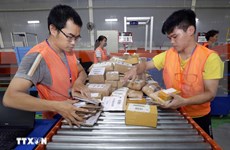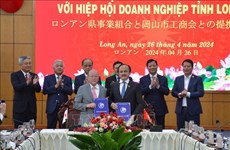Overseas investments struggle
The rate of return on overseas
investments by Vietnamese firms has been very poor, although the
investment volume has risen steadily over the last few years, officials
say.
The rate of return on overseas
investments by Vietnamese firms has been very poor, although the
investment volume has risen steadily over the last few years, officials
say.
The Foreign Investment Agency (FIA) under the Ministry of Planning and Investment says local enterprises have transferred a total of 1.79 billion USD to invest in foreign countries since 1989, when Vietnam began investing abroad.
But profit repatriated to Vietnam was 39 million USD in the last 21 years, a return of just 0.46 percent, the agency estimates.
However, the actual figure may be higher since many investors have not reported their business performance to the authorities, says Bui Quoc Trung, FIA deputy director.
In addition, investors often reinvest in their projects, and thus profit repatriation is lower than expected. He also notes that although Vietnamese firms started investing abroad in 1989, overseas investment only took off in a significant way in 2006.
Local firms have invested in 410 projects abroad since 2006 with a total registered capital of 7.05 billion USD.
In the 1989-99 period, only 17 projects with a combined capital of 13.6 million USD were licensed.
The Vietnam Oil and Gas Group (PetroVietnam) has so far invested 1.05 billion USD abroad and repatriated profits of more than 31 million USD.
The low rate of return has raised concerns about the efficiency of overseas investment.
One expert has said although it is true that country has more than profit motives when it promotes Vietnamese investment in other countries, both the Government and the companies should consider financial efficiency before starting a project.
Another official from the Ministry of Finance says local firms should invest overseas only if the investment offers higher profits than at home, if the project can provide materials that cannot be found in Vietnam, or if there is a supply shortage of those materials in the country.
Otherwise, enterprises should not invest abroad, especially in the current situation when local companies are short of capital.
Trung of FIA says that in the long-term, investment efficiency could improve, but some adjustments need to be made in the short term.
There has been an imbalance between cash outflow and inflow from overseas projects. With a large amount of capital expected to go out of Vietnam, the capital source for local investment will certainly be affected and there will be added pressure on national balance of payment.
This will affect directly the country's macroeconomic balance, and therefore, proper measures are necessary to harmonise overseas and local investments, he adds.
According to the Ministry of Planning and Investment, by the end of last year, Vietnam had invested in 465 projects worth 7.73 billion USD in more than 50 countries and territories.
Processing and manufacturing industries ranked first with 102 projects worth 429 million USD.
With nearly 170 projects worth 3.16 billion USD, Laos has so far been the most attractive destination for Vietnamese investors.
Russia follows with 17 projects totaling 1.71 billion USD./.
The Foreign Investment Agency (FIA) under the Ministry of Planning and Investment says local enterprises have transferred a total of 1.79 billion USD to invest in foreign countries since 1989, when Vietnam began investing abroad.
But profit repatriated to Vietnam was 39 million USD in the last 21 years, a return of just 0.46 percent, the agency estimates.
However, the actual figure may be higher since many investors have not reported their business performance to the authorities, says Bui Quoc Trung, FIA deputy director.
In addition, investors often reinvest in their projects, and thus profit repatriation is lower than expected. He also notes that although Vietnamese firms started investing abroad in 1989, overseas investment only took off in a significant way in 2006.
Local firms have invested in 410 projects abroad since 2006 with a total registered capital of 7.05 billion USD.
In the 1989-99 period, only 17 projects with a combined capital of 13.6 million USD were licensed.
The Vietnam Oil and Gas Group (PetroVietnam) has so far invested 1.05 billion USD abroad and repatriated profits of more than 31 million USD.
The low rate of return has raised concerns about the efficiency of overseas investment.
One expert has said although it is true that country has more than profit motives when it promotes Vietnamese investment in other countries, both the Government and the companies should consider financial efficiency before starting a project.
Another official from the Ministry of Finance says local firms should invest overseas only if the investment offers higher profits than at home, if the project can provide materials that cannot be found in Vietnam, or if there is a supply shortage of those materials in the country.
Otherwise, enterprises should not invest abroad, especially in the current situation when local companies are short of capital.
Trung of FIA says that in the long-term, investment efficiency could improve, but some adjustments need to be made in the short term.
There has been an imbalance between cash outflow and inflow from overseas projects. With a large amount of capital expected to go out of Vietnam, the capital source for local investment will certainly be affected and there will be added pressure on national balance of payment.
This will affect directly the country's macroeconomic balance, and therefore, proper measures are necessary to harmonise overseas and local investments, he adds.
According to the Ministry of Planning and Investment, by the end of last year, Vietnam had invested in 465 projects worth 7.73 billion USD in more than 50 countries and territories.
Processing and manufacturing industries ranked first with 102 projects worth 429 million USD.
With nearly 170 projects worth 3.16 billion USD, Laos has so far been the most attractive destination for Vietnamese investors.
Russia follows with 17 projects totaling 1.71 billion USD./.












